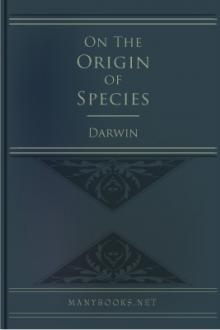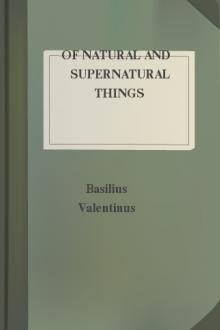The Origin of Species by means of Natural Selection (6th ed), Charles Darwin [the beginning after the end read novel .TXT] 📗

- Author: Charles Darwin
- Performer: -
Book online «The Origin of Species by means of Natural Selection (6th ed), Charles Darwin [the beginning after the end read novel .TXT] 📗». Author Charles Darwin
So it is with hybrids, for their offspring in successive generations are eminently liable to vary, as every experimentalist has observed.
Thus we see that when organic beings are placed under new and unnatural conditions, and when hybrids are produced by the unnatural crossing of two species, the reproductive system, independently of the general state of health, is affected in a very similar manner. In the one case, the conditions of life have been disturbed, though often in so slight a degree as to be inappreciable by us; in the other case, or that of hybrids, the external conditions have remained the same, but the organisation has been disturbed by two distinct structures and constitutions, including of course the reproductive systems, having been blended into one. For it is scarcely possible that two organisations should be compounded into one, without some disturbance occurring in the development, or periodical action, or mutual relations of the different parts and organs one to another or to the conditions of life. When hybrids are able to breed inter se, they transmit to their offspring from generation to generation the same compounded organisation, and hence we need not be surprised that their sterility, though in some degree variable, does not diminish; it is even apt to increase, this being generally the result, as before explained, of too close interbreeding. The above view of the sterility of hybrids being caused by two constitutions being compounded into one has been strongly maintained by Max Wichura.
It must, however, be owned that we cannot understand, on the above or any other view, several facts with respect to the sterility of hybrids; for instance, the unequal fertility of hybrids produced from reciprocal crosses; or the increased sterility in those hybrids which occasionally and exceptionally resemble closely either pure parent. Nor do I pretend that the foregoing remarks go to the root of the matter: no explanation is offered why an organism, when placed under unnatural conditions, is rendered sterile. All that I have attempted to show is, that in two cases, in some respects allied, sterility is the common result—in the one case from the conditions of life having been disturbed, in the other case from the organisation having been disturbed by two organisations being compounded into one.
A similar parallelism holds good with an allied yet very different class of facts. It is an old and almost universal belief, founded on a considerable body of evidence, which I have elsewhere given, that slight changes in the conditions of life are beneficial to all living things. We see this acted on by farmers and gardeners in their frequent exchanges of seed, tubers, etc., from one soil or climate to another, and back again. During the convalescence of animals, great benefit is derived from almost any change in their habits of life. Again, both with plants and animals, there is the clearest evidence that a cross between individuals of the same species, which differ to a certain extent, gives vigour and fertility to the offspring; and that close interbreeding continued during several generations between the nearest relations, if these be kept under the same conditions of life, almost always leads to decreased size, weakness, or sterility.
Hence it seems that, on the one hand, slight changes in the conditions of life benefit all organic beings, and on the other hand, that slight crosses, that is, crosses between the males and females of the same species, which have been subjected to slightly different conditions, or which have slightly varied, give vigour and fertility to the offspring.
But, as we have seen, organic beings long habituated to certain uniform conditions under a state of nature, when subjected, as under confinement, to a considerable change in their conditions, very frequently are rendered more or less sterile; and we know that a cross between two forms that have become widely or specifically different, produce hybrids which are almost always in some degree sterile. I am fully persuaded that this double parallelism is by no means an accident or an illusion. He who is able to explain why the elephant, and a multitude of other animals, are incapable of breeding when kept under only partial confinement in their native country, will be able to explain the primary cause of hybrids being so generally sterile. He will at the same time be able to explain how it is that the races of some of our domesticated animals, which have often been subjected to new and not uniform conditions, are quite fertile together, although they are descended from distinct species, which would probably have been sterile if aboriginally crossed. The above two parallel series of facts seem to be connected together by some common but unknown bond, which is essentially related to the principle of life; this principle, according to Mr. Herbert Spencer, being that life depends on, or consists in, the incessant action and reaction of various forces, which, as throughout nature, are always tending towards an equilibrium; and when this tendency is slightly disturbed by any change, the vital forces gain in power.
RECIPROCAL DIMORPHISM AND TRIMORPHISM.
This subject may be here briefly discussed, and will be found to throw some light on hybridism. Several plants belonging to distinct orders present two forms, which exist in about equal numbers and which differ in no respect except in their reproductive organs; one form having a long pistil with short stamens, the other a short pistil with long stamens; the two having differently sized pollen-grains. With trimorphic plants there are three forms likewise differing in the lengths of their pistils and stamens, in the size and colour of the pollen-grains, and in some other respects; and as in each of the three forms there are two sets of stamens, the three forms possess altogether six sets of stamens and three kinds of pistils.
These organs are so proportioned in length to each other that half the stamens in two of the forms stand on a level with the stigma of the third form. Now I have shown, and the result has been confirmed by other observers, that in order to obtain full fertility with these plants, it is necessary that the stigma of the one form should be fertilised by pollen taken from the stamens of corresponding height in another form. So that with dimorphic species two unions, which may be called legitimate, are fully fertile; and two, which may be called illegitimate, are more or less infertile. With trimorphic species six unions are legitimate, or fully fertile, and twelve are illegitimate, or more or less infertile.
The infertility which may be observed in various dimorphic and trimorphic plants, when they are illegitimately fertilised, that is by pollen taken from stamens not corresponding in height with the pistil, differs much in degree, up to absolute and utter sterility; just in the same manner as occurs in crossing distinct species. As the degree of sterility in the latter case depends in an eminent degree on the conditions of life being more or less favourable, so I have found it with illegitimate unions. It is well known that if pollen of a distinct species be placed on the stigma of a flower, and its own pollen be afterwards, even after a considerable interval of time, placed on the same stigma, its action is so strongly prepotent that it generally annihilates the effect of the foreign pollen; so it is with the pollen of the several forms of the same species, for legitimate pollen is strongly prepotent over illegitimate pollen, when both are placed on the same stigma. I ascertained this by fertilising several flowers, first illegitimately, and twenty-four hours afterwards legitimately, with pollen taken from a peculiarly coloured variety, and all the seedlings were similarly coloured; this shows that the legitimate pollen, though applied twenty-four hours subsequently, had wholly destroyed or prevented the action of the previously applied illegitimate pollen.
Again, as in making reciprocal crosses between the same two species, there is occasionally a great difference in the result, so the same thing occurs with trimorphic plants; for instance, the mid-styled form of Lythrum salicaria was illegitimately fertilised with the greatest ease by pollen from the longer stamens of the short-styled form, and yielded many seeds; but the latter form did not yield a single seed when fertilised by the longer stamens of the mid-styled form.
In all these respects, and in others which might be added, the forms of the same undoubted species, when illegitimately united, behave in exactly the same manner as do two distinct species when crossed. This led me carefully to observe during four years many seedlings, raised from several illegitimate unions. The chief result is that these illegitimate plants, as they may be called, are not fully fertile. It is possible to raise from dimorphic species, both long-styled and short-styled illegitimate plants, and from trimorphic plants all three illegitimate forms. These can then be properly united in a legitimate manner. When this is done, there is no apparent reason why they should not yield as many seeds as did their parents when legitimately fertilised. But such is not the case. They are all infertile, in various degrees; some being so utterly and incurably sterile that they did not yield during four seasons a single seed or even seed-capsule. The sterility of these illegitimate plants, when united with each other in a legitimate manner, may be strictly compared with that of hybrids when crossed inter se. If, on the other hand, a hybrid is crossed with either pure parent-species, the sterility is usually much lessened: and so it is when an illegitimate plant is fertilised by a legitimate plant. In the same manner as the sterility of hybrids does not always run parallel with the difficulty of making the first cross between the two parent-species, so that sterility of certain illegitimate plants was unusually great, while the sterility of the union from which they were derived was by no means great. With hybrids raised from the same seed-capsule the degree of sterility is innately variable, so it is in a marked manner with illegitimate plants. Lastly, many hybrids are profuse and persistent flowerers, while other and more sterile hybrids produce few flowers, and are weak, miserable dwarfs; exactly similar cases occur with the illegitimate offspring of various dimorphic and trimorphic plants.
Altogether there is the closest identity in character and behaviour between illegitimate plants and hybrids. It is hardly an exaggeration to maintain that illegitimate plants are hybrids, produced within the limits of the same species by the improper union of certain forms, while ordinary hybrids are produced from an improper union between so-called distinct species. We have also already seen that there is the closest similarity in all respects between first illegitimate unions and first crosses between distinct species. This will perhaps be made more fully apparent by an illustration; we may suppose that a botanist found two well-marked varieties (and such occur) of the long-styled form of the trimorphic Lythrum salicaria, and that he determined to try by crossing whether they were specifically distinct. He would find that they yielded only about one-fifth of the proper number of seed, and that they behaved in all the other





Comments (0)